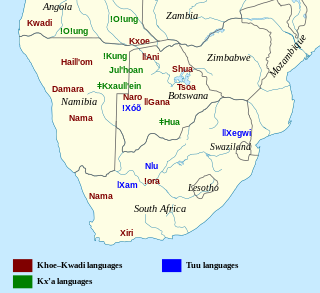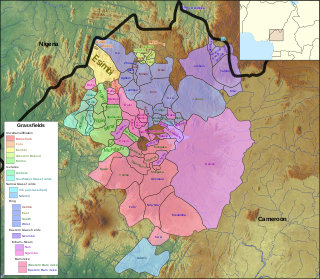
TaaTAH, also known as ǃXóõKOH, is a Tuu language notable for its large number of phonemes, perhaps the largest in the world. It is also notable for having perhaps the heaviest functional load of click consonants, with one count finding that 82% of basic vocabulary items started with a click. Most speakers live in Botswana, but a few hundred live in Namibia. The people call themselves ǃXoon or ʼNǀohan, depending on the dialect they speak. The Tuu languages are one of the three traditional language families that make up the Khoisan languages. In 2011, there were around 2,500 speakers of Taa.
The phonology of Portuguese varies among dialects, in extreme cases leading to some difficulties in mutual intelligibility. This article on phonology focuses on the pronunciations that are generally regarded as standard. Since Portuguese is a pluricentric language, and differences between European Portuguese (EP), Brazilian Portuguese (BP), and Angolan Portuguese (AP) can be considerable, varieties are distinguished whenever necessary.
ǂʼAmkoeAM-koy, formerly called by the dialectal name ǂHoan, is a severely endangered Kxʼa language of Botswana. West ǂʼAmkoe dialect, along with Taa and Gǀui, form the core of the Kalahari Basin sprachbund, and share a number of characteristic features, including the largest consonant inventories in the world. ǂʼAmkoe was shown to be related to the Juu languages by Honken and Heine (2010), and these have since been classified together in the Kxʼa language family.
Bernese German, like other High Alemannic varieties, has a two-way contrast in plosives and fricatives that is not based on voicing, but on length. The absence of voice in plosives and fricatives is typical for all High German varieties, but many of them have no two-way contrast due to general lenition.
The phonology of the Persian language varies between regional dialects, standard varieties, and even from older variates of Persian. Persian is a pluricentric language and countries that have Persian as an official language have separate standard varieties, namely: Standard Dari (Afghanistan), Standard Iranian Persian (Iran) and Standard Tajik (Tajikistan). The most significant differences between standard varieties of Persian are their vowel systems. Standard varieties of Persian have anywhere from 6 to 8 vowel distinctions, and similar vowels may be pronounced differently between standards. However, there are not many notable differences when comparing consonants, as all standard varieties a similar amount of consonant sounds. Though, colloquial varieties generally have more differences than their standard counterparts. Most dialects feature contrastive stress and syllable-final consonant clusters. Linguists tend to focus on Iranian Persian, so this article may contain less adequate information regarding other varieties.
The Sikkimese language, also called Sikkimese, Bhutia, or Drenjongké, Dranjoke, Denjongka, Denzongpeke and Denzongke, belongs to the Tibeto-Burman languages. It is spoken by the Bhutia in Sikkim, India, and in parts of Koshi, Nepal. It is the official language in Sikkim. The Sikkimese people refer to their own language as Drendzongké and their homeland as Drendzong. Up until 1975, Sikkimese was not a written language. After gaining Indian statehood, the language was introduced as a school subject in Sikkim and the written language was developed.
Iau or Turu is a Lakes Plain language of West Papua, Indonesia, spoken by about 2,100 people, native speakers of this language are the Turu people (Iau). Most speakers are monolingual, and their number is growing. Other peoples in the western Lakes Plain area speak basic Iau. Iau is heavily tonal, with 11 tones on nouns and 19 simple and compound tones on verbs.
Unlike many languages, Icelandic has only very minor dialectal differences in sounds. The language has both monophthongs and diphthongs, and many consonants can be voiced or unvoiced.
The phonology of Sesotho and those of the other Sotho–Tswana languages are radically different from those of "older" or more "stereotypical" Bantu languages. Modern Sesotho in particular has very mixed origins inheriting many words and idioms from non-Sotho–Tswana languages.
Taos is a Tanoan language spoken by several hundred people in New Mexico, in the United States. The main description of its phonology was contributed by George L. Trager in a (pre-generative) structuralist framework. Earlier considerations of the phonetics-phonology were by John P. Harrington and Jaime de Angulo. Trager's first account was in Trager (1946) based on fieldwork 1935-1937, which was then substantially revised in Trager (1948). The description below takes Trager (1946) as the main point of departure and notes where this differs from the analysis of Trager (1948). Harrington's description is more similar to Trager (1946). Certain comments from a generative perspective are noted in a comparative work Hale (1967).
The most thorough treatment of the Kiowa sound system is by Laurel Watkins in a generative framework. A consideration of prosodic phenomena with acoustic analysis is in Sivertsen (1956). Earlier discussions of phonemics are Trager (1960), Merrifield (1959), Wonderly et al. (1954), and Harrington (1928).
This article is about the sound system of the Navajo language. The phonology of Navajo is intimately connected to its morphology. For example, the entire range of contrastive consonants is found only at the beginning of word stems. In stem-final position and in prefixes, the number of contrasts is drastically reduced. Similarly, vowel contrasts found outside of the stem are significantly neutralized. For details about the morphology of Navajo, see Navajo grammar.
Izi is an Igboid language spoken in Ebonyi state in Nigeria. It forms a dialect cluster with the closely related languages Ikwo, Ezza, and Mgbo.
The phonology of Burmese is fairly typical of a Southeast Asian language, involving phonemic tone or register, a contrast between major and minor syllables, and strict limitations on consonant clusters.
Kensiu (Kensiw) is an Austroasiatic language of the Jahaic subbranch. It is spoken by a small community of 300 people in Yala Province in southern Thailand and also reportedly by a community of approximately 300 speakers in Western Malaysia in Perak and Kedah states. Speakers of this language are Negritos who are known as the Mani people or Maniq of Thailand.

Babanki, or Kejom, is a Bantoid language that is spoken by the Babanki people of the Western Highlands of Cameroon.
Avava (Navava), also known as Katbol, Tembimbe-Katbol, or Bangsa’ is an Oceanic language of central Malekula, Vanuatu. It has nasalized fricatives and a bilabial trill.
The phonology of Old Saxon mirrors that of the other ancient Germanic languages, and also, to a lesser extent, that of modern West Germanic languages such as English, Dutch, Frisian, German, and Low German.
Gumuz is a dialect cluster spoken along the border of Ethiopia and Sudan. It has been tentatively classified within the Nilo-Saharan family. Most Ethiopian speakers live in Kamashi Zone and Metekel Zone of the Benishangul-Gumuz Region, although a group of 1,000 reportedly live outside the town of Welkite. The Sudanese speakers live in the area east of Er Roseires, around Famaka and Fazoglo on the Blue Nile, extending north along the border. Dimmendaal et al. (2019) suspect that the poorly attested varieties spoken along the river constitute a distinct language, Kadallu.

